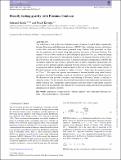Directly testing gravity with Proxima Centauri
Abstract
The wide binary orbit of Proxima Centauri around α Centauri A and B differs significantly between Newtonian and Milgromian dynamics (MOND). By combining previous calculations of this effect with mock observations generated using a Monte Carlo procedure, we show that this prediction can be tested using high precision astrometry of Proxima Centauri. This requires ≈10 yr of observations at an individual epoch precision of 0.5 μas, within the design specifications of the proposed Theia mission. In general, the required duration should scale as the 2/5 power of the astrometric precision. A long-period planet could produce a MOND-like astrometric signal, but only if it has a particular ratio of mass to separation squared and a sky position close to the line segment connecting Proxima Centauri with α Centauri. Uncertainties in perspective effects should be small enough for this test if the absolute radial velocity of Proxima Centauri can be measured to within ≈10 ms-1, better than the present accuracy of 32 ms-1. We expect the required improvement to become feasible using radial velocity zero-points estimated from larger samples of close binaries, with the Sun providing an anchor. We demonstrate that possible astrometric microlensing of Proxima Centauri is unlikely to affect the results. We also discuss why it should be possible to find sufficiently astrometrically stable reference stars. Adequately, addressing these and other issues would enable a decisive test of gravity in the currently little explored low acceleration regime relevant to the dynamical discrepancies in galactic outskirts.
Citation
Banik , I & Kroupa , P 2019 , ' Directly testing gravity with Proxima Centauri ' , Monthly Notices of the Royal Astronomical Society , vol. 487 , no. 2 , pp. 1653-1661 . https://doi.org/10.1093/mnras/stz1379
Publication
Monthly Notices of the Royal Astronomical Society
Status
Peer reviewed
ISSN
0035-8711Type
Journal article
Description
Funding Information: IB is supported by an Alexander von Humboldt postdoctoral fellowship.Collections
Items in the St Andrews Research Repository are protected by copyright, with all rights reserved, unless otherwise indicated.

